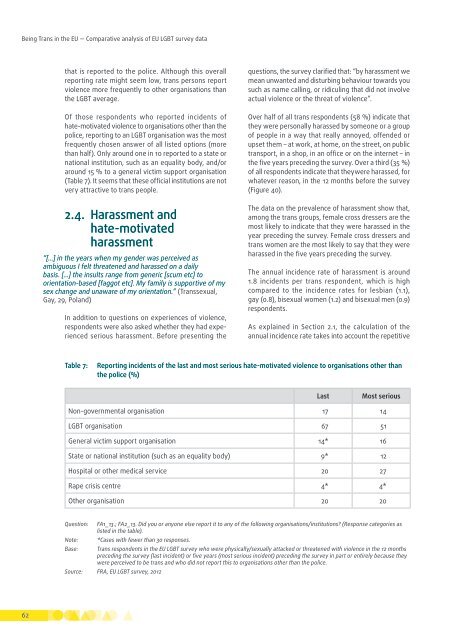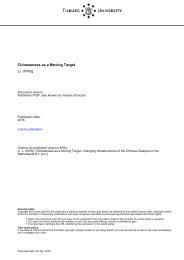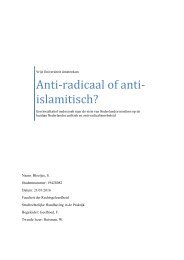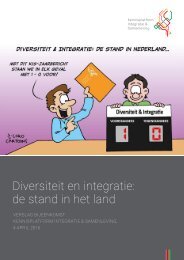fra-2014-being-trans-eu-comparative_en
fra-2014-being-trans-eu-comparative_en
fra-2014-being-trans-eu-comparative_en
You also want an ePaper? Increase the reach of your titles
YUMPU automatically turns print PDFs into web optimized ePapers that Google loves.
Being Trans in the EU — Comparative analysis of EU LGBT survey datathat is reported to the police. Although this overallreporting rate might seem low, <strong>trans</strong> persons reportviol<strong>en</strong>ce more frequ<strong>en</strong>tly to other organisations thanthe LGBT average.Of those respond<strong>en</strong>ts who reported incid<strong>en</strong>ts ofhate‐motivated viol<strong>en</strong>ce to organisations other than thepolice, reporting to an LGBT organisation was the mostfrequ<strong>en</strong>tly chos<strong>en</strong> answer of all listed options (morethan half). Only around one in 10 reported to a state ornational institution, such as an equality body, and/oraround 15 % to a g<strong>en</strong>eral victim support organisation(Table 7). It seems that these official institutions are notvery attractive to <strong>trans</strong> people.2.4. Harassm<strong>en</strong>t andhate‐motivatedharassm<strong>en</strong>t“[…] in the years wh<strong>en</strong> my g<strong>en</strong>der was perceived asambiguous I felt threat<strong>en</strong>ed and harassed on a dailybasis. […] the insults range from g<strong>en</strong>eric [scum etc] toori<strong>en</strong>tation‐based [faggot etc]. My family is supportive of mysex change and unaware of my ori<strong>en</strong>tation.” (Transsexual,Gay, 29, Poland)In addition to questions on experi<strong>en</strong>ces of viol<strong>en</strong>ce,respond<strong>en</strong>ts were also asked whether they had experi<strong>en</strong>cedserious harassm<strong>en</strong>t. Before pres<strong>en</strong>ting thequestions, the survey clarified that: “by harassm<strong>en</strong>t wemean unwanted and disturbing behaviour towards yousuch as name calling, or ridiculing that did not involveactual viol<strong>en</strong>ce or the threat of viol<strong>en</strong>ce”.Over half of all <strong>trans</strong> respond<strong>en</strong>ts (58 %) indicate thatthey were personally harassed by someone or a groupof people in a way that really annoyed, off<strong>en</strong>ded orupset them – at work, at home, on the street, on public<strong>trans</strong>port, in a shop, in an office or on the internet – inthe five years preceding the survey. Over a third (35 %)of all respond<strong>en</strong>ts indicate that theywere harassed, forwhatever reason, in the 12 months before the survey(Figure 40).The data on the preval<strong>en</strong>ce of harassm<strong>en</strong>t show that,among the <strong>trans</strong> groups, female cross dressers are themost likely to indicate that they were harassed in theyear preceding the survey. Female cross dressers and<strong>trans</strong> wom<strong>en</strong> are the most likely to say that they wereharassed in the five years preceding the survey.The annual incid<strong>en</strong>ce rate of harassm<strong>en</strong>t is around1.8 incid<strong>en</strong>ts per <strong>trans</strong> respond<strong>en</strong>t, which is highcompared to the incid<strong>en</strong>ce rates for lesbian (1.1),gay (0.8), bisexual wom<strong>en</strong> (1.2) and bisexual m<strong>en</strong> (0.9)respond<strong>en</strong>ts.As explained in Section 2.1, the calculation of theannual incid<strong>en</strong>ce rate takes into account the repetitiveTable 7:Reporting incid<strong>en</strong>ts of the last and most serious hate‐motivated viol<strong>en</strong>ce to organisations other thanthe police (%)LastMost seriousNon‐governm<strong>en</strong>tal organisation 17 14LGBT organisation 67 51G<strong>en</strong>eral victim support organisation 14* 16State or national institution (such as an equality body) 9* 12Hospital or other medical service 20 27Rape crisis c<strong>en</strong>tre 4* 4*Other organisation 20 20Question:Note:Base:FA1_13.; FA2_13. Did you or anyone else report it to any of the following organisations/institutions? (Response categories aslisted in the table).*Cases with fewer than 30 responses.Trans respond<strong>en</strong>ts in the EU LGBT survey who were physically/sexually attacked or threat<strong>en</strong>ed with viol<strong>en</strong>ce in the 12 monthspreceding the survey (last incid<strong>en</strong>t) or five years (most serious incid<strong>en</strong>t) preceding the survey in part or <strong>en</strong>tirely because theywere perceived to be <strong>trans</strong> and who did not report this to organisations other than the police.Source: FRA, EU LGBT survey, 201262









